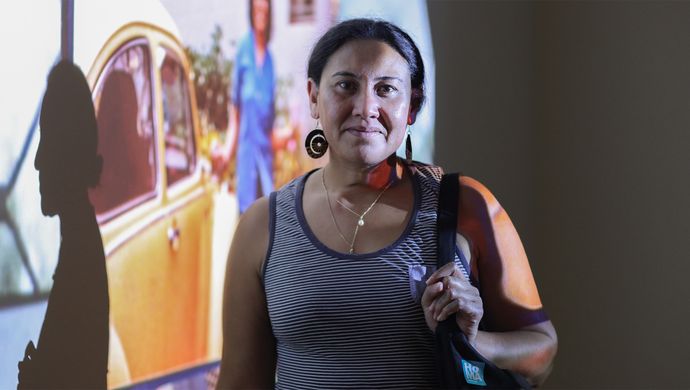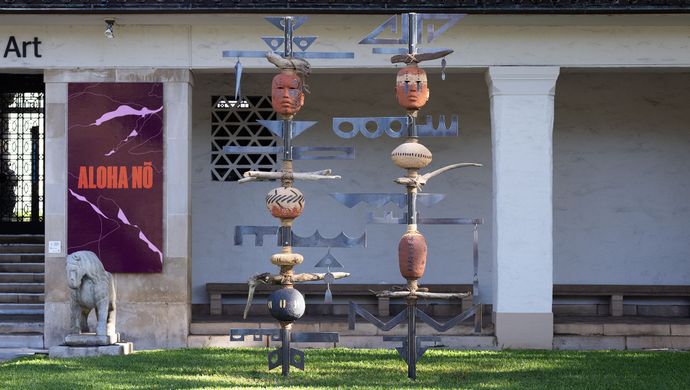HT25 at HoMA: Hayv Kahraman on Hawaiian snails, folk tales, and flax
Kahraman, who is Iraqi American and based in Los Angeles, spent time in Hawai‘i last year to do research for her three pieces. Intrigued by the endangered Hawaiian land snail, Kahraman worked with malacologists such as Bishop Museum’s Norine Yeung. Her many-layered works—Gamla o Bargouth, Fire Spiral, and Makua Valley—also reference things such as an Arabic folk tale and the military occupation of O‘ahu, all connected through her paintings. Kahraman uses flax to create a sort of canvas, the surface gossamer and delicate in some areas and like the disintegrating hide of a dead animal in others.
In anticipation of her talk, HoMA asked Kahraman six questions about her HT25 work.
How did you discover the story of Hawaiian land snails, and what about them led to inspiring your work for HT25?
I first came to the snails through a manifesto that Donna Haraway and Mike Hadfield wrote in 2019 called the Tree Snail Manifesto. This led me to Thom Van Dooren’s excellent book A World in a Shell: Snail Stories for a Time of Extinctions, which followed me throughout the work I was doing and during my site visit.
My fascination or rather obsession with these kahuli is multifaceted and somewhat difficult to put into words. The fact that they are on the brink of extinction makes me question what that truly means to the ecosystem, to kanaka, to endemic trees and leaves, and to the forest and the birds. This is not only a story of endangered snails. It is a story of grief and ecocide.
Donna Haraway writes, “Grief is a path to understanding entangled shared living and dying; human beings must grieve with, because we are in and of this fabric of undoing. Without sustained remembrance, we cannot learn to live with ghosts and so cannot think.”
This grieving happens in a multispecies world. Somehow I am entangled with these snails and I feel the grief and I feel the connection to them and this is probably the most valuable lesson for me. That I am deeply connected to something as small as a snail.
Do snails play a part in all three works?
Yes they do. There are multiple ways to approach all these works. I see my work as entering into labyrinths of questions, from snails to multispecies stories that I was told as a child in West Asia, to questions on grief and re-worlding and how to live with ghosts.
Hayv Kahraman. Fire Spiral. 2025 (detail). Oil and acrylic on flax.
What was it like working with Norine Yeung and other malacologists at Bishop Museum, and how did the experience inform your work?
I met with the entire snail community in Honolulu. Ken [Hayes] and Nori from Bishop Museum, Mike Hadfield and David Sisco. I was immensely grateful for the time they took to explain their work and was struck by their dedication to these snails. I kept thinking, How can I contribute to this as an artist?
Walking into the malacology department at Bishop Museum was emotional. The museum houses around six million snail shells, one of the biggest collections in the world. There are numerous corridors with top to bottom storage units with draws that contain little boxes with millions of shells. I felt like I was in a mortuary. Each shell is numbered so as to correspond to an identification system. Ken let me roam the department as I pleased. So I spent hours looking at different shells, some with incredible patterns that resemble tribal lines. I wasn’t only surrounded by remnants, I felt that I was in the presence of ghosts.
Two of your works, Makua Valley and Gamla o Bargouth, use flax. It’s like you’ve created a whole new kind of textile. Why flax, and what is your process working with flax to make this “canvas”?
Flax is a material akin to hair, produced by the flax plant, extracted with the aid of a bacteria that separates the stalk from the fiber as it is grown and then cut to lay on the soil. Flax is usually spun into thread and woven into linen, a material we’ve used for thousands of years as garments. In relatively recent history linen was introduced in Venice as a painting substrate. In an effort to think in a more multispecies way and move beyond linen as a European substrate, I wanted to re-weave the material into something different. The process of remaking linen, i.e. weaving flax, became ritualistic. There’s an unraveling and re-making happening in the studio. The shapes are all taken from tessellated patterns I grew up seeing in Kurdistan and Iraq. These are geometric shapes usually woven into rugs holding their own meaning. I distinctly remember my aunt telling me the story of the flea and the louse as I sat on one of these rugs.
Another inspiration for your work is the Arabic fable Gamla and Barghooth, or the Flea and the Louse. The Brothers Grimm tales also include a story called the Louse and the Flea, in which all the creatures die by drowning. It seems to be a universal tale. For you, how does this story intertwine with the sad story of disappearing Hawaiian land snails and how does that manifest in your works?
This is a story I was told by my great aunt in northern Iraq. It begins with the flea and the louse sitting on the edge of a tannour (a concave oven) warming themselves. The flea accidentally slips and falls into the oven and explodes. Louse feels devastated and starts shedding all her hair, when the crow flies over and hears this news he starts plucking out all his feathers. The palm tree hears the news, feels the grief and starts shedding her fronds and fruit, then water buffalo breaks her leg and the river dries herself up, ultimately ending in the mother removing her panties and sitting on a saj oven (a convex oven used to make thin bread), thereby burning her womb.
There must be several versions of this story as you see this one ends with fire. It’s an apocalyptic story that highlights the entangled and relational more than human world. Perhaps it’s a story of climate change or extinction. Perhaps of war-torn ecologies or the violence of settler colonialism. What is clear is that we are left with a feeling of connectivity to our more than human kin by means of ruin.
However, I don’t think that this story is only about grief. Just like the snails, this is a story that breaks down human individualism and speaks to a multi sentient, entangled world. It’s a story that highlights accountability and responsibility. It’s a story of the incredibly colorful shells belonging to the endangered snail species (Achatinella) that lose their shell luster once they die. Kanaka maoli believe that these snails once sung in the deep forests of Hawai‘i. What happens when the forest can’t sing any longer?
Hayv Kahraman. Makua Valley, 2025. Oil and acrylic on flax.
What do you want residents of O‘ahu who are familiar with Makua Valley to take away from experiencing your work Makua Valley?
I first want to say that I understand that I am someone who is coming in from elsewhere, who knows very little about this. My interest in Makua Valley and the reason I chose to title the work “Makua Valley” was because that was the place Mike Hadfield had first found remnants of dead snail shells with artillery shells embedded inside their bodies. I asked Mike to send me the coordinates of these shells that he found deep inside the valley. I then transcribed them on the heads of the figures in the painting.
This is a sacred place. A place that holds generational love and joy. And for many years it has been desecrated by the Army. I can relate to this personally. To be extracted from my land and for my land to end up becoming a container of toxic artillery remnants. How does one contend with this pain? Perhaps the snails can help us find openings and ways to re-world.



 Interview
Interview



 Story
Story

